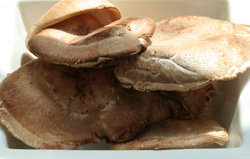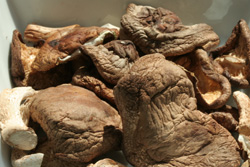Why dried shitake mushrooms can taste better than fresh --
FLAVOR BOOSTING TIPS
GENERAL INFORMATION ON SHIITAKE MUSHROOMS
The two most popular mushrooms in the world are the common button mushroom (Agaricus species) and the shiitake or black forest mushroom (Lentinus edodes). The shiitake, meaning "mushroom of the shii or oak tree" in Japanese, is highly prized in the Orient for its flavor and reputed medicinal value.
Shiitake are native to China but have been grown in both Japan and China since prehistoric times. They have been cultivated for over 1000 years; the first written record of shiitake cultivation can be traced to Wu Sang Kwuang, born during the Song Dynasty (AD 960–1127). However, some documents record the uncultivated mushroom being eaten as early as AD 199. During the Ming Dynasty (AD 1368–1644), physician Wu Juei wrote that the mushroom could be used not only as a food but was taken as a remedy for upper respiratory diseases, poor blood circulation, liver trouble, exhaustion and weakness, and to boost qi, or life energy. It was also believed to prevent premature aging.
CULTIVATION OF THE SHIITAKE MUSHROOM
Before 1982 the Japanese variety of these mushrooms could only be grown in traditional locations using ancient methods. In the late 1970s, Gary F. Leatham published a doctoral thesis based on his research on the budding and growth of the Japan Islands variety; the work helped make commercial cultivation possible worldwide, and Dr. Leatham is now known in the industry as the "Father of Shiitake farming in the USA."
DRIED SHIITAKE MUSHROOMS
Shiitake are often dried and sold as preserved food in packages. These must be rehydrated by soaking in water before using. Many people prefer dried shiitake to fresh, considering that the sun-drying process draws out the umami flavour from the dried mushrooms by breaking down proteins into amino acids and transforms ergosterol to vitamin D. The stems of shiitake are rarely used in Japanese and other cuisine's, primarily because the stems are harder and take longer to cook than the soft fleshy caps. But using the stems in stocks will greatly enhance the broth.
WHY ARE SUN DRIED SHIITAKE MUSHROOMS RICHER IN FLAVOR?
When Shitake mushrooms and similar mushrooms e.g., Porcini mushrooms are dried in the sun complex proteins are broken down into simpler amino acids (e.g., glutamate) yielding a stronger Umami Flavor. In addition when mushrooms are dried, their guanylate (nucleotide) which also contributes to Umami flavor increases. Read more about Umami as the 5th taste.

FRESH SHIITAKE MUSHROOMS

DRIED SHIITAKE MUSHROOMS --
Dried Shiitake Mushrooms are richer in flavor than fresh mushrooms; complex proteins are broken down to simpler amino acids (e.g., glutamate) yielding a stronger Umami taste. Sun Dried Shiitake mushrooms increases Vitamin D.
References
1 -- Kim H, Kacew S, Lee B (1999). "In vitro chemopreventive effects of plant polysaccharides (Aloe barbadensis miller, Lentinus edodes, Ganoderma lucidum and Coriolus versicolor)". Carcinogenesis 20 (8): 1637–40.
2 -- Yamamoto Y, Shirono H, Kono K, Ohashi Y. (Nov 1997), "Immunopotentiating activity of the water-soluble lignin rich fraction prepared from LEM--the extract of the solid culture medium of Lentinus edodes mycelia.", Biosci Biotechnol Biochem. 61 (11): 1909–12.
3 -- Ng ML, Yap AT (2002), "Inhibition of human colon carcinoma development by lentinan from shiitake mushrooms (Lentinus edodes).", J Altern Complement Med. 8 (5): 581–9.
4 -- Gu YH, Belury MA. (Mar 2005), "Selective induction of apoptosis in murine skin carcinoma cells (CH72) by an ethanol extract of Lentinula edodes.", Cancer Lett. 220 (1): 21–8.
5 -- Takehara M, Kuida K, Mori K (1979). "Antiviral activity of virus-like particles from Lentinus edodes (Shiitake)". Archives of Virology 59 (3): 269–74.
6 -- Shimada S, Komamura K, Kumagai H, Sakurai H (2004). "Inhibitory activity of shiitake flavor against platelet aggregation". Biofactors 22 (1-4): 177–9.
7 -- Spierings EL, Fujii H, Sun B et al. (2007). A Phase I study of the safety of the nutritional supplement, active hexose correlated compound, AHCC, in healthy volunteers. J Nutr Sci Vitaminol. 53:536-539.
8 -- Terakawa N, Matsui Y, Satoi S et al. (2008). Immunological effect of active hexose correlated compound (AHCC) in healthy volunteers: a double-blind, placebo-controlled study. Nutr Cancer. 60:643-651
9 --Dietary Eritadenine Modifies Plasma Phosphatidylcholine Molecular Species Profile in Rats Fed Different Types of Fat Manuscript received 20 May 1996. Initial reviews completed 24 June 1996. Revision accepted 14 November 1996. Kimio Sugiyama, Akihiro Yamakawa, Hirokazu Kawagishi, and Shigeru Saeki*-- Read Full Text
10 --Nakano H, Namatame K, Nemoto H, Motohashi H, Nishiyama K, Kumada K (1999). "A multi-institutional prospective study of lentinan in advanced gastric cancer patients with unresectable and recurrent diseases: effect on prolongation of survival and improvement of quality of life. Kanagawa Lentinan Research Group". Hepatogastroenterology 46 (28): 2662–8
Science of Cooking
See also: